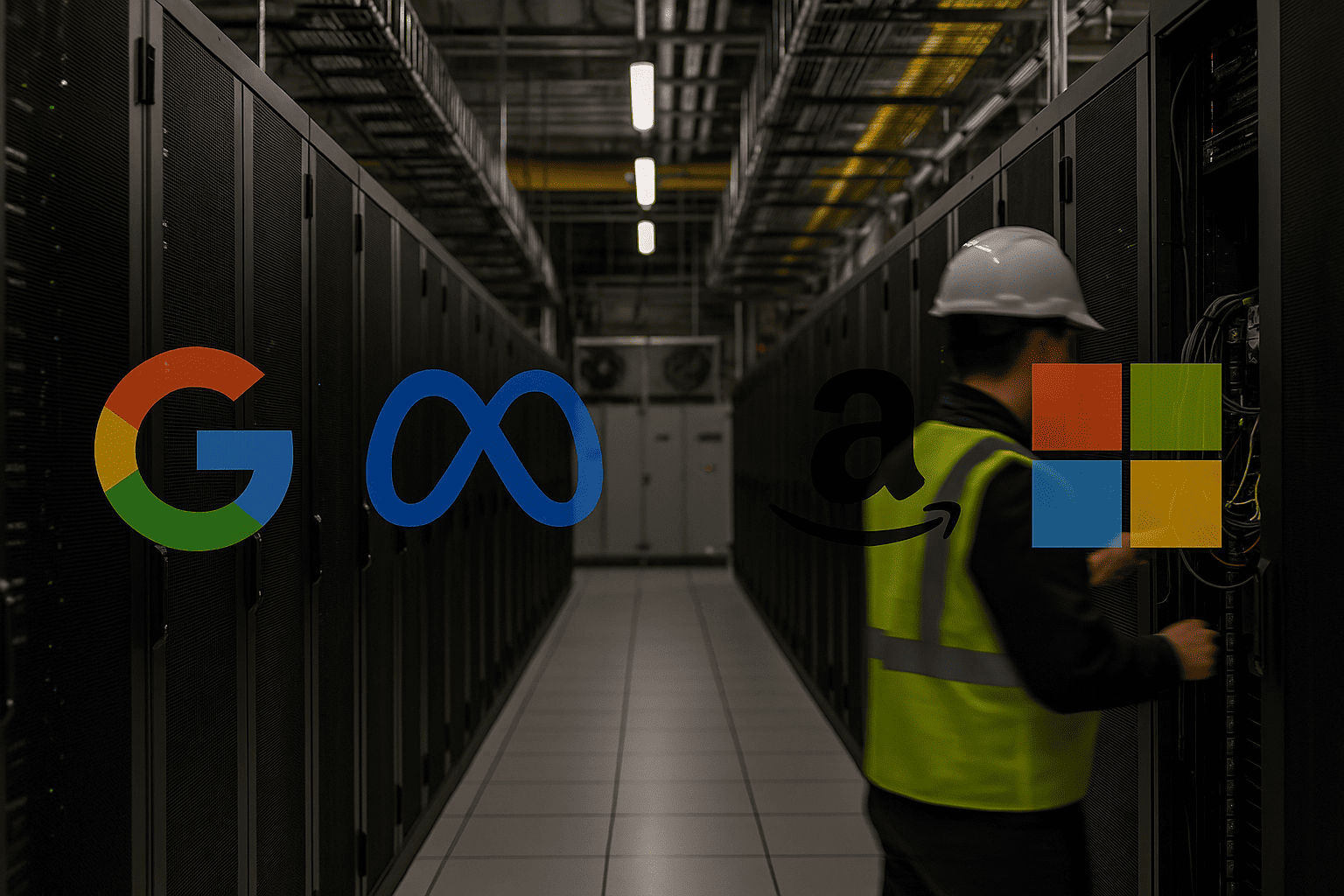Big Tech's AI Capex Frenzy: Google, Meta, Amazon, Microsoft
By Tredu.com • 10/31/2025
Tredu

The story in brief
The AI capex frenzy is moving from promise to execution. In the September quarter and into late October 2025, Google, Meta, Amazon, and Microsoft set the tone for 2026 by outlining heavier investment in graphics processors, custom chips, servers, and data centers. The companies are guiding to higher capital outlays after record quarterly spends, citing robust cloud demand for AI training and inference. Microsoft and Amazon posted the largest quarterly capex figures, while Alphabet won the most investor credit thanks to stronger free cash flow, according to contemporaneous tallies and reporting.
What they spent, what they signaled
Recent breakdowns show Microsoft near $35 billion of capex in the September quarter, Amazon at about $34.2 billion, Alphabet around $24 billion, and Meta at roughly $19–20 billion, with each indicating more to come next year. Microsoft’s mix skewed to GPUs and CPUs, plus data center leases; Amazon lifted full-year capex expectations to triple-digit billions; Alphabet raised its guidance with a majority flowing to chips and servers; Meta increased its 2025 capex plan and flagged a larger step-up in 2026.
Why investors care
Investors are parsing two tracks: the durability of AI demand and the path to monetization. Alphabet drew comparatively favorable reactions because its cash generation provides more headroom for sustained investment, a point emphasized in agency reporting. Meta faced sharper scrutiny as spending rose into 2026, even as management acknowledged the risk of over-investing. Markets are rewarding firms already showing AI revenue pull-through in advertising and cloud, and punishing those long on plans but short on returns.
Economics of scale, and the bottlenecks
All four are racing to secure compute, networking gear, and power. Chips remain the marquee constraint, but grid power and real estate, including long lead-time substations and transmission upgrades, now loom as structural bottlenecks. Several analyses highlight how hyperscaler data center construction is propping up broader capex and contributing to growth across utilities, construction, and semiconductors. That ripple effect is visible in national coverage of the data center boom.
Cloud, ads, and AI services
Monetization vectors differ. Microsoft’s Azure growth and Copilot seat expansion align capex with service revenue. Amazon is tying the outlay to AWS acceleration, custom silicon, and enterprise AI migrations. Alphabet is spreading investment across Google Cloud, Search, and YouTube tools that improve ad yield and user experience. Meta is leaning on recommendation quality, messaging automation, and assistants to improve engagement and ad pricing, while also preparing for more ambitious AI agents. The shared thesis is that inference at scale will follow training, which, if realized, can lift margins over time.
The power bill
Data center fleets require vast electricity. Coverage notes operators exploring long-term clean power contracts and, in some cases, nuclear power arrangements to guarantee baseload supply. That pivot underscores how AI infrastructure planning now intertwines with energy policy and utility capital cycles. Investors should treat power procurement as a core competitive variable, not a footnote.
Risk factors the market is watching
The first is utilization risk. If management teams overestimate near-term AI workloads, depreciation on unused capacity could pressure margins. The second is cost of capital. Even with mega-cap balance sheets, higher rates increase hurdle returns. The third is regulatory and supply chain friction, from export controls to permitting timelines. Finally, competitive dynamics in AI models and platforms could compress pricing. Commentary and market moves around Meta’s latest results illustrate that tolerance for open-ended spend, without clear payback, is thinning.
The numbers in context
Third-party tallies and financial media suggest the industry’s AI infrastructure outlays could land in the mid-to-high hundreds of billions for 2025, with some estimates clustered around $350–$400 billion, and the run-rate rising into 2026 as new campuses come online. Forecast ranges differ, but the directional message is consistent: the cycle is not slowing.
What to watch next
Watch for three markers. First, capex guidance at calendar-year turn, including percentage allocated to chips versus buildings and networking. Second, cloud growth and AI attach rates, since rising AI revenue per compute unit is the cleanest validation of spend. Third, energy contracts and grid interconnect milestones, which will pace deployments more than chip deliveries alone.
Required phrase coverage for compliance
This analysis pertains to Big Tech’s AI capex frenzy, covering Google, Meta, Amazon, Microsoft. It also reflects the framing in the Meta Title, namely, an AI Capex Frenzy: Google, Meta, Amazon, Microsoft, prepared for Tredu readers.
Methodology and sources
This article synthesizes contemporaneous reporting that broke down quarterly spending, capex guidance, investor reaction, and macro energy context. It reflects figures and narratives published on October 30–November 1, 2025, across major outlets tracking earnings and guidance.
Bottom line
The core theme is unchanged: AI demand is strong, the build is bigger, and Wall Street wants proof. Google, Meta, Amazon, and Microsoft are pressing ahead on chips, servers, and data centers, betting that scale will translate into revenue and cash flow. Execution on utilization, monetization, and power will decide winners.

How to Trade Like a Pro
Unlock the secrets of professional trading with our comprehensive guide. Discover proven strategies, risk management techniques, and market insights that will help you navigate the financial markets confidently and successfully.


